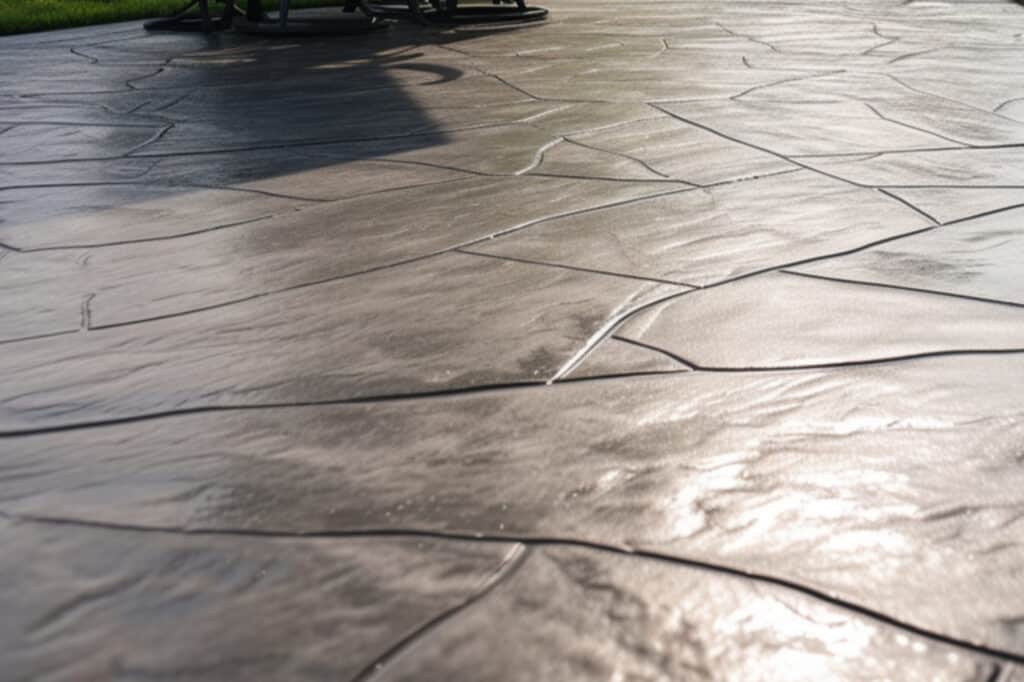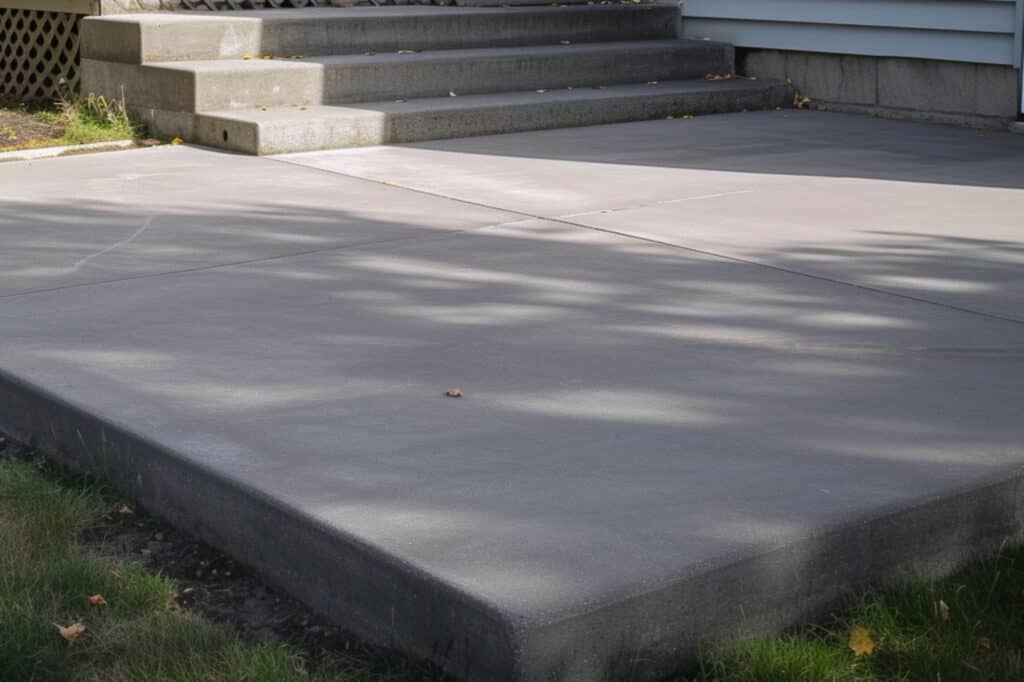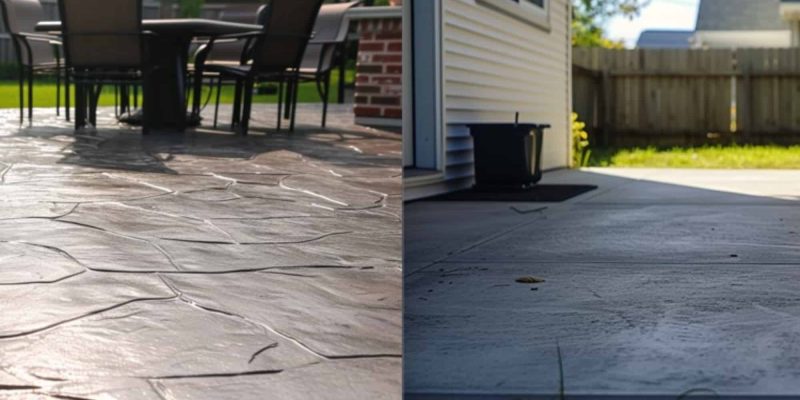Welcome to our guide on stamped vs regular concrete! In considering concrete work, understanding these two popular options is crucial. This post will explore their differences, helping you decide on your next project. Let’s dive into the fascinating world of concrete and discover what works best for you.
What is Stamped Concrete?
Stamped concrete is a creative and versatile form of concrete widely used in modern construction. Essentially, it’s regular concrete that’s been skillfully imprinted with patterns or textures, often to mimic other materials like brick, stone, slate, or wood. This transformation happens when concrete is still wet, allowing for a variety of artistic designs.
Introduced several decades ago, stamped concrete has grown in popularity due to its ability to elevate the aesthetic appeal of driveways, patios, and walkways. Unlike regular concrete, stamped varieties offer a broad spectrum of designs, making each installation unique. The possibilities are endless, from intricate geometric patterns to realistic replications of natural materials.
What is Regular Concrete?
Regular concrete, also known as plain or traditional concrete, is the most common type used in construction. It’s a simple mix of water, cement, sand, and aggregate (like gravel or stone). This mixture is poured into molds or directly onto surfaces and then allowed to harden, forming a strong and durable material.
Regular concrete is a popular choice for foundational work, sidewalks, and driveways, where the primary concern is functionality and strength rather than appearance. It’s the backbone of many structures, valued for its reliability and longevity. Regular concrete is straightforward to prepare and lay, making it a practical option for a wide range of construction projects.
What Are The Differences: Stamped Concrete vs Regular Concrete
Differences in Appearance
The appearance of concrete plays a significant role in its selection. Stamped and regular concrete differ greatly in their aesthetic appeal.
Stamped concrete is known for its decorative versatility. It can mimic high-end materials like natural stone, brick, or wood, thanks to a variety of colors, patterns, and textures available. This ability to replicate other materials allows stamped concrete to blend seamlessly with different architectural styles, adding a sophisticated and customized look to any property. Whether you desire a cobblestone pathway or a slate patio, stamped concrete can achieve that look with impressive accuracy.
On the other hand, regular concrete has a more uniform and plain appearance. It’s typically a smooth, gray surface without patterns or elaborate designs. While it might lack the visual impact of stamped concrete, its simplicity can be a perfect match for certain design aesthetics.
The choice between stamped and regular concrete often comes down to the desired visual effect. If you’re aiming for a standout feature in your landscaping, stamped concrete is the way to go. Regular concrete is a reliable and straightforward option for more understated, functional areas.
Cost Comparison
When considering a concrete project, cost is often a deciding factor. Understanding the cost differences between stamped and regular concrete is crucial for budget planning.
Stamped concrete typically has a higher initial cost than regular concrete. This is due to the extra labor involved in applying patterns and colors and the additional materials required for its decorative features. The complexity of the design also influences the price – more intricate patterns and multiple colors will increase costs, like in stamped concrete patios. However, the aesthetic appeal and potential to boost property value can make this investment worthwhile for many homeowners.

Regular concrete, in contrast, is more budget friendly. Its straightforward mix and simpler installation process result in lower costs. It’s a cost-effective solution for large areas like driveways or foundations where aesthetics is less of a priority. Regular concrete offers durability and functionality at a more accessible price point.
While stamped concrete may initially appear more expensive, it’s essential to factor in the long-term maintenance costs. Both stamped and regular concrete require upkeep, but stamped concrete often demands more involved maintenance, which could increase its overall lifetime cost.
Ultimately, the choice depends on your priorities: if aesthetic appeal is paramount and you’re open to a higher investment, stamped concrete is an excellent choice. Conversely, regular concrete offers a sensible and reliable option if you’re focused on affordability and practicality.
Design Options
The design options between stamped and regular concrete are markedly different, offering varying levels of customization.
Stamped concrete shines in its design versatility. It can be customized with a wide array of patterns, textures, and colors. Homeowners can choose from designs that mimic natural stone, brick, wood, and even more intricate patterns like floral motifs or geometric shapes. This flexibility allows for personalization to match any home’s exterior or landscape design. With stamped concrete, you can create a unique, eye-catching surface that reflects your personal style.
In contrast, regular concrete offers limited design options. Its primary appeal lies in its simplicity and functionality. The standard finish is a smooth, gray surface, which can be altered with basic coloring or by adding a broom finish to create a slightly textured surface. While these options are more limited, they suit homeowners who prefer a clean, unembellished look or for areas where functionality is more important than aesthetics.
The choice between stamped and regular concrete in terms of design depends on the desired outcome and personal taste. Stamped concrete is ideal for those who want to make a statement with their property, while regular concrete is best for practical, no-nonsense applications.
Durability and Longevity
Durability and longevity are critical considerations for any concrete installation. Both stamped and regular concrete offer robust performance, but their longevity can vary based on several factors.
Stamped concrete can last as long as regular concrete when properly installed and maintained. However, its longevity can be influenced by the quality of installation, the sealant used, and maintenance practices. The sealant, which enhances the color and pattern, needs to be reapplied every few years to protect against fading and wear. Stamped concrete is also slightly more prone to cracking in harsh weather conditions, which can impact its longevity if not properly addressed.
Regular concrete, known for its strength and durability, typically has a longer lifespan when used in standard applications like driveways and walkways. It’s less susceptible to damage from heavy loads and harsh weather, making it a reliable choice for functional areas. Regular maintenance for regular concrete is relatively straightforward, often involving simple cleaning and occasional crack repair.
Stamped and regular concretes are susceptible to damage from freeze-thaw…
Both types of concrete are susceptible to damage from freeze-thaw cycles. Proper installation and regular maintenance are key to maximizing the lifespan of either type of concrete. In summary, while stamped concrete offers aesthetic appeal, it may require more maintenance, whereas regular concrete provides durability with minimal upkeep.
Installation Process
The installation process of stamped and regular concrete differs significantly, each with its own set of steps and considerations.
For stamped concrete, the installation is more intricate. It starts like regular concrete – mixing water, cement, sand, and aggregate – but with the addition of color. Once poured, the surface is smoothed, and then the stamping process begins while the concrete is still wet. Stamps are pressed into the concrete to create patterns, and this must be done carefully and quickly before the concrete sets. This process requires skilled labor and attention to detail to ensure that the patterns are consistent and aesthetically pleasing. The final step involves applying a sealant, which enhances the color and protects the pattern.
Regular concrete installation is more straightforward. The mixture is poured into the desired area and then leveled to create a smooth surface. Sometimes, a broom is dragged across the surface to create a non-slip texture. The simplicity of this process makes it faster and less labor-intensive compared to stamped concrete.

It’s crucial for both types of concrete to be installed under the right conditions to avoid issues like cracking. Stamped concrete requires more planning and precision, reflecting its higher installation cost compared to regular concrete.
Pattern and Texture Variations
The pattern and texture variations in stamped and regular concrete significantly influence their aesthetic and functional characteristics, providing distinct choices.
Stamped concrete offers extensive pattern and texture options, allowing for creative and diverse designs. Homeowners can select from various textures that mimic natural materials like stone, slate, brick, or wood. These textures are visually appealing and provide a tactile quality to the surface. The patterns can range from simple, single-tone designs to intricate multi-patterned and colored layouts. This variety enables stamped concrete to be tailored to match any architectural style or landscape design, providing a unique and customized appearance.
In contrast, regular concrete typically has a smooth finish or a simple broom finish, adding a slight texture to the surface. The broom finish is practical, offering slip resistance, which is especially useful for driveways and walkways. While the design options for regular concrete are limited compared to stamped concrete, its simplicity can be ideal for those seeking a minimalist or more traditional look.
NOTE
Choosing between stamped and regular concrete often depends on the desired visual impact and the specific functional needs of the project. Stamped concrete is perfect for adding a decorative touch, while regular concrete is suitable for straightforward, functional surfaces.
Pros and Cons of Stamped Concrete
Stamped concrete, popular for its aesthetic appeal, comes with its own set of advantages and disadvantages.
Pros
- Aesthetic Appeal: Stamped concrete’s greatest advantage is its stunning visual quality. It can dramatically enhance the look of a property with its ability to mimic high-end materials.
- Variety: A wide range of patterns, colors, and textures are available, offering limitless design possibilities to match any style.
- Property Value: By improving the property’s curb appeal, stamped concrete can potentially increase a home’s market value.
Cons
- Cost: Stamped concrete is generally more expensive than regular concrete due to the intricate installation process and materials required.
- Maintenance: It requires more upkeep, including resealing every few years to maintain its color and pattern.
- Potential for Damage: Stamped concrete can be prone to cracking and fading, especially if not properly installed or maintained.
Pros and Cons of Regular Concrete
Regular concrete, while less ornate than stamped concrete, has its own merits and limitations.
Pros
- Durability: Known for its strength and longevity, regular concrete is ideal for high-traffic areas and load-bearing applications.
- Low Cost: It is more affordable than stamped concrete in terms of initial installation and long-term maintenance.
- Simplicity: Its straightforward installation process and minimal maintenance make it a practical choice for many homeowners.
Cons
- Limited Design Options: Regular concrete offers limited aesthetic options, mostly confined to a plain, gray surface.
- Aesthetic Appeal: Lacking stamped concrete’s decorative qualities may not significantly enhance the property’s curb appeal.
- Texture and Finish: While functional, regular concrete’s standard smooth or broom finish lacks stamped varieties’ creative appeal.
Conclusion
While stamped concrete may initially appear more expensive, it’s essential to factor in the long-term maintenance costs. Both stamped and regular concrete require upkeep, but stamped concrete often demands more involved maintenance, which could increase its overall lifetime cost. Ultimately, the choice depends on your priorities: if aesthetic appeal is paramount and you’re open to a higher investment, stamped concrete is an excellent choice. Conversely, regular concrete offers a sensible and reliable option if you’re focused on affordability and practicality.
Frequently Asked Questions
Is stamped concrete as strong as regular concrete?
Stamped concrete typically matches the strength and durability of regular concrete when installed and maintained correctly. Both are made from a similar mix of cement, aggregates, and water, ensuring comparable structural integrity. However, the longevity of stamped concrete can be influenced by factors like the quality of installation, the type of sealant used, and maintenance practices. Regular concrete is known for its robustness in high-traffic areas, making it a reliable choice for practical applications.
Does stamped concrete crack more than regular concrete?
Stamped concrete can be more prone to cracking compared to regular concrete, particularly if not installed properly. The stamping process, which involves pressing patterns into the concrete, can create weak points where cracks may develop. Additionally, stamped concrete requires expansion joints to allow for movement and prevent cracking, which must be strategically placed for aesthetics and functionality. Regular concrete, with its simpler installation process, tends to have fewer issues with cracking when installed under ideal conditions.
How does the price of stamped concrete compare to regular concrete?
Stamped concrete typically comes at a higher price point compared to regular concrete. This is attributed to the additional labor and materials required for stamping and coloring to achieve various patterns and designs. The intricate nature of the work and the customization options available with stamped concrete contribute to its higher cost. On the other hand, regular concrete, being less labor-intensive and requiring fewer materials for its standard finish, is more cost-effective, making it a preferred choice for those on a tighter budget.

